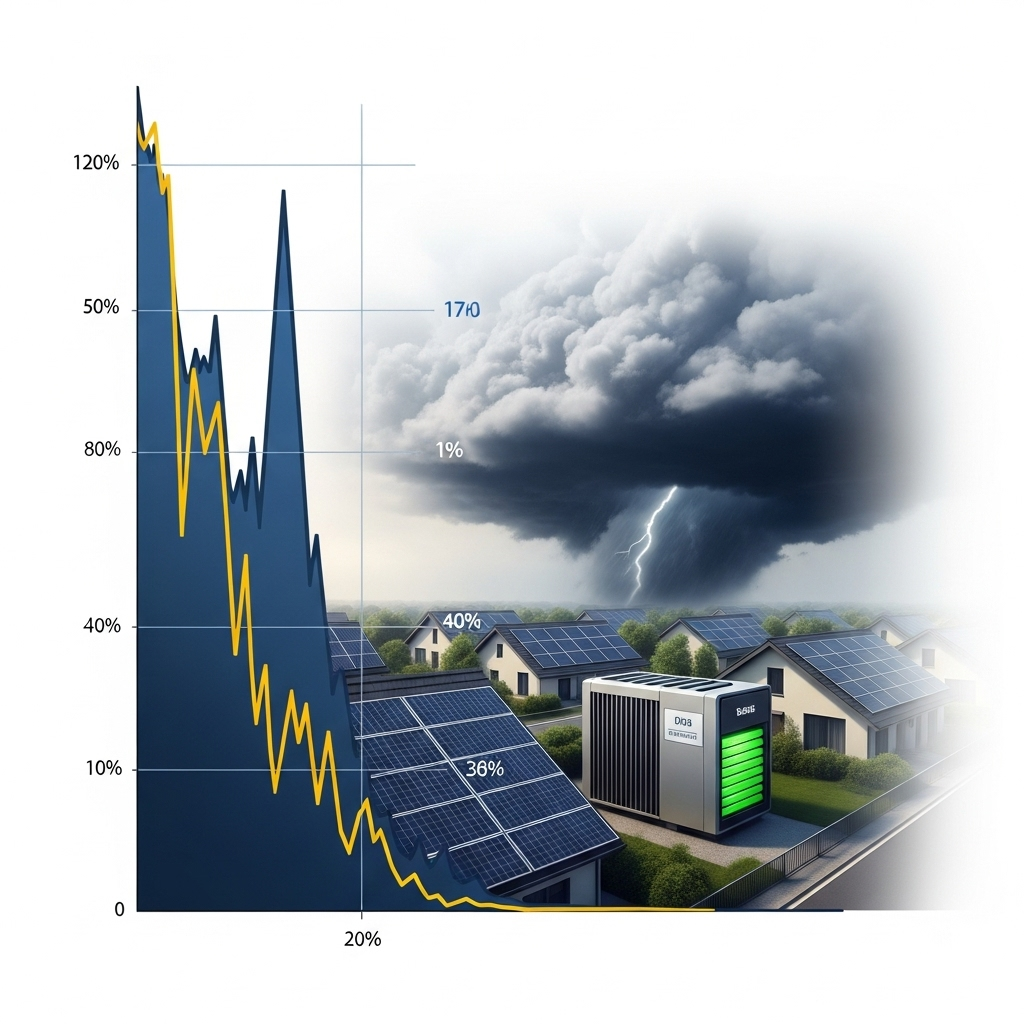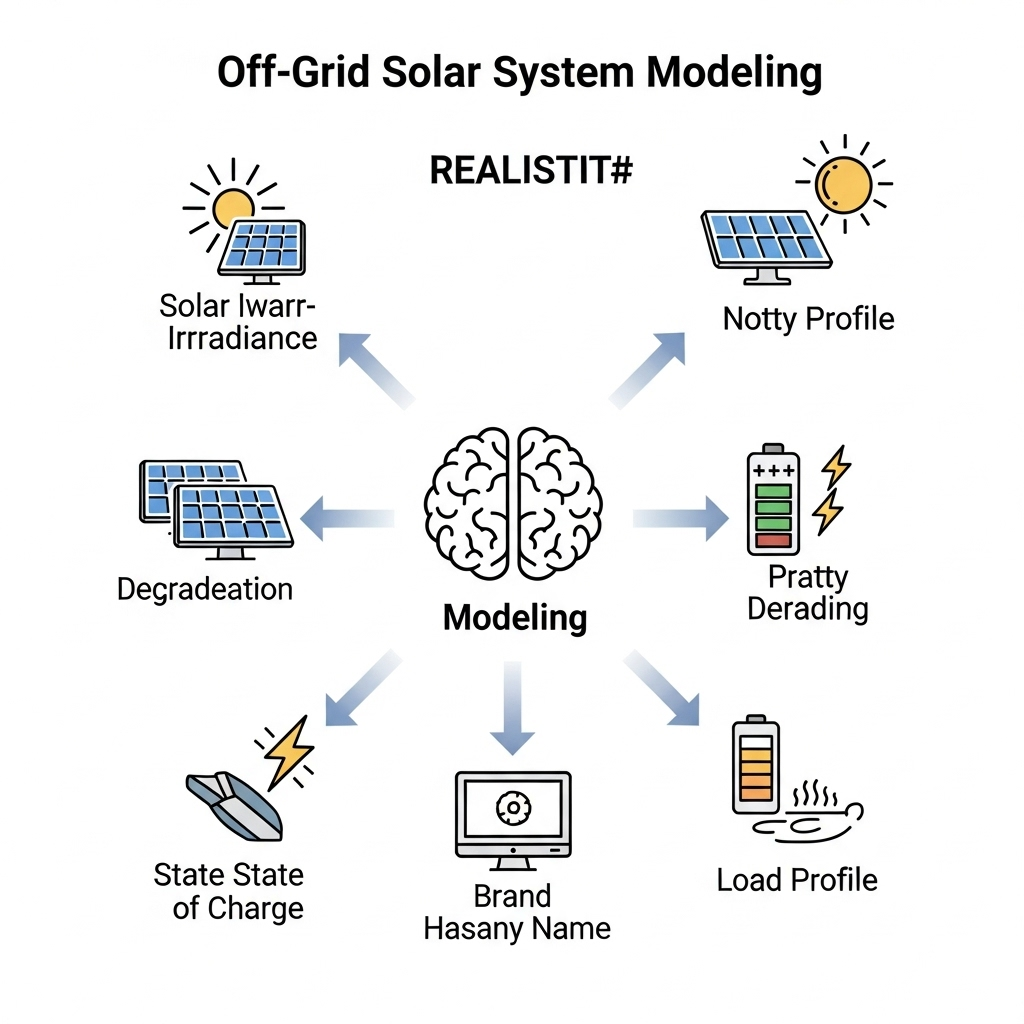Solar microgrids offer a path to energy independence, but their performance hinges on more than just sunny days. The real test of a system's resilience lies in its ability to handle rapid fluctuations in power output. These fluctuations, known as ramp rates, are often triggered by extreme weather events. Understanding and managing them is critical for ensuring stable power and achieving projected long-term yield. This report analyzes the data behind these events and provides strategies for building a robust microgrid.
Understanding Solar Variability and Ramp Rates
The output of a solar panel array can change dramatically from one minute to the next. This variability is a defining characteristic of solar power and presents a unique challenge for microgrid design and operation. A stable and reliable system must be engineered to handle these shifts seamlessly.
The Nature of Solar Power Fluctuation
Solar power's variability is distinct from other renewable sources like wind. As noted in an IEA report on energy transformation, solar generation follows a predictable daily and seasonal pattern based on planetary motion. However, this predictable base is overlaid with unpredictable, high-frequency changes caused by cloud cover, fog, or even passing objects. This combination of predictable cycles and random events creates a complex output profile that microgrids must manage.
Defining Ramp Rates
A ramp rate is the speed at which a power plant's output increases or decreases. For solar PV systems, these ramps can be incredibly steep. A fast-moving cloud can cause a solar array's output to plummet by 80-90% in under a minute. Conversely, as the cloud passes, the output can surge back just as quickly. These frequent and sharp changes are a primary source of instability in a poorly designed microgrid.
Why Ramp Rates Matter for Microgrids
In a microgrid, especially an off-grid one, the balance between power generation and consumption must be maintained in real-time. A sudden drop in solar generation without an immediate backup source can lead to voltage sags or frequency deviations, potentially tripping sensitive electronics or causing a system-wide shutdown. A sudden surge can overwhelm the system if there's no way to absorb the excess energy. Managing these ramps is fundamental to providing reliable, high-quality power.
The Impact of Extreme Weather Events on Microgrid Performance
While daily cloud cover is the most common cause of ramps, more severe weather events pose an even greater threat to microgrid stability and long-term asset health. These events test the limits of every component in the system.
Sudden Cloud Cover and Its Effects
The most frequent 'extreme event' for a solar array is the rapid onset of thick cloud cover. When a large cloud blocks the sun, the power output drops almost instantly. An energy storage system (ESS) must react in milliseconds to discharge power and cover the deficit, ensuring connected loads experience no interruption. The speed and magnitude of this response are determined by the battery's power rating (kW) and the inverter's capabilities.
Other Weather Phenomena
Beyond simple clouds, microgrids must be prepared for other weather challenges. Thunderstorms can bring not only rapid changes in irradiance but also lightning, which requires robust surge protection. Heavy snowfall can completely cover panels for extended periods, reducing output to zero. In arid regions, dust storms can cause severe soiling, which degrades performance over time and necessitates frequent cleaning. Each of these events introduces uncertainty into long-term yield forecasts.
Quantifying the Impact on Long-Term Yield
Individually, a ramp event might only last a few minutes. However, their cumulative effect significantly impacts a system's total energy production. A system that cannot effectively manage these ramps will suffer from frequent, small-scale interruptions or inefficiencies. This leads to a lower-than-expected long-term yield and can reduce the return on investment. Accurate yield forecasting must account for the probability and severity of these sub-hourly events.
Designing Resilient Microgrids: The Role of Energy Storage
A properly specified energy storage system is the key to taming solar variability. It acts as a dynamic buffer, absorbing shocks and smoothing the power delivered to your home or business. The choice of battery technology and system sizing is paramount.
The Critical Function of LiFePO4 Batteries
Lithium Iron Phosphate (LiFePO4) batteries are exceptionally well-suited for managing high ramp rates. Their chemistry allows for very high charge and discharge rates without significant degradation or safety concerns. When a cloud causes solar output to drop, a LiFePO4 battery can instantly inject power into the microgrid. When the sun returns, it can absorb the resulting power surge, protecting the system and storing the energy for later use. This rapid response capability is what ensures a seamless and stable power supply.
Sizing Your ESS for Ramp Rate Management
Sizing an ESS for a microgrid involves more than just calculating daily energy needs (kWh). You must also consider the power requirement (kW) needed to counteract the steepest expected ramp. A battery system might have enough energy storage but lack the power output to compensate for a sudden 90% drop in solar generation. Understanding key metrics is vital for this. For a comprehensive overview, the ultimate reference on solar storage performance provides crucial data on C-rates, depth of discharge, and efficiency, which directly influence a battery's ability to handle ramps.
Advanced Inverter and Control Strategies
The battery is the muscle, but the hybrid inverter and system controller are the brain. Modern hybrid inverters are designed to manage multiple power sources (solar, battery, grid/generator) simultaneously. They constantly monitor grid frequency and voltage, using sophisticated algorithms to command the battery to charge or discharge in fractions of a second. This intelligent control is what enables a microgrid to operate with the stability of a national grid, a key factor in projects aiming to increase community resilience through microgrid networks.
Data-Driven Insights and Mitigation Strategies
Building a resilient microgrid is an engineering challenge that benefits from robust data and proven strategies. By analyzing the unique characteristics of solar power, we can design systems that are prepared for real-world conditions.
Analyzing Sub-Hourly Data
Traditional solar resource assessments often use hourly data, which completely masks the rapid fluctuations that occur within that hour. To properly design for ramp rates, it is necessary to use sub-hourly, or even second-by-second, data. This high-resolution data reveals the true extent of solar variability and allows engineers to size inverters and batteries to handle peak ramps, not just average conditions.
Comparative Analysis: Solar vs. Wind Power Ramps
To put solar variability in context, it's helpful to compare it with wind power. While both are variable renewable energy sources, their patterns of fluctuation are quite different. This distinction has significant implications for system design and the role of energy storage.
| Characteristic | Wind Power | Solar PV |
|---|---|---|
| Variability at Plant Level | Often random on sub-seasonal timescales | Follows planetary motion with statistical overlay (clouds) |
| Ramps | Depends on resource; typically fewer extreme events | Frequent, repetitive, and often very steep |
| Uncertainty | Shape and timing of generation are unknown | Scaling factor of a known shape is unknown |
| Technology | Non-synchronous and mechanical | Non-synchronous and electronic |
Data adapted from IEA analysis on integrating renewables.
Practical Mitigation Plays
To build a microgrid that can withstand extreme events and manage high ramp rates, you should prioritize the following actions:
- Invest in High-Performance ESS: Select a LiFePO4 battery system with a power rating (kW) sufficient to cover the loss from your solar array during a rapid cloud event.
- Choose a Capable Hybrid Inverter: Ensure your inverter has a fast response time and advanced control features specifically designed for microgrid stabilization.
- Implement Smart Monitoring: Use a system that provides real-time data on power flow. This allows you to observe how your system performs during ramp events and helps in diagnosing any potential issues.
- Do Not Undersize Components: Sizing components based on average conditions will lead to underperformance and premature failure. Design for the extremes. The successful ramp-up of solar production, as discussed in the IEA's special report on solar supply chains, depends on the availability of high-quality components capable of handling these stresses.
Looking Ahead: Building Future-Proof Solar Microgrids
The challenge of solar variability is not a barrier to energy independence; it is an engineering parameter to be solved. By understanding the data behind extreme events and ramp rates, we can design and build solar microgrids that are not only productive but also exceptionally reliable. The core of this resilience lies in a well-integrated system where a fast-responding LiFePO4 energy storage system works in concert with an intelligent inverter. This combination transforms an intermittent energy source into a firm, dependable power supply, delivering the security and long-term value that users expect.
Frequently Asked Questions
What is a solar ramp rate?
A solar ramp rate measures how quickly the power output of a solar energy system changes. It is typically expressed in kilowatts per minute (kW/min). High ramp rates, often caused by fast-moving clouds, can create instability in a microgrid if not managed properly by an energy storage system.
How does a LiFePO4 battery help manage ramp rates?
A LiFePO4 battery helps by acting as a fast-acting power buffer. When solar output drops suddenly, the battery instantly discharges to supply the missing power, ensuring a stable supply to your loads. When solar output surges, the battery absorbs the excess energy, preventing system overloads and storing the power for later.
Why is my solar system producing less power than expected on cloudy days?
While some production is expected on cloudy days from diffuse light, overall output is lower. More importantly, the constant fluctuations from moving clouds can cause some systems to underperform if they are not equipped to handle the rapid ramps. An effective energy storage system smooths these fluctuations, maximizing the usable energy captured.
Can my microgrid handle a sudden power surge from the solar panels?
This depends on your system's design. A microgrid with a properly sized hybrid inverter and energy storage system can handle a power surge. The inverter will direct the excess power to the battery for storage. Without a battery or a sufficiently advanced inverter, a sudden surge could potentially damage equipment or force the inverter to curtail production, wasting energy.





Leave a comment
All comments are moderated before being published.
This site is protected by hCaptcha and the hCaptcha Privacy Policy and Terms of Service apply.